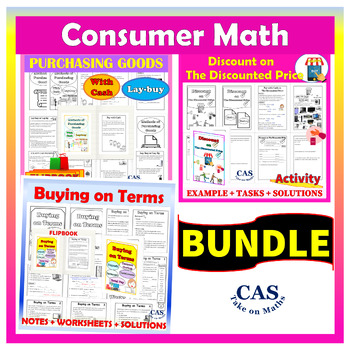Consumer Math Bundle | Shopping | Cash -Lay-buy - Buying on Terms
CAS Take on Maths
248 Followers
Grade Levels
8th - 11th
Subjects
Resource Type
Standards
CCSS7.RP.A.3
CCSSMP1
Formats Included
- Zip
- Easel Activity
Pages
3 Resources in One Bundle
CAS Take on Maths
248 Followers
Easel Activities Included
Some resources in this bundle include ready-to-use interactive activities that students can complete on any device. Easel by TPT is free to use! Learn more.
Products in this Bundle (3)
Description
Consumer Math Bundle.
3 Resources included in this bundle.
- Consumer Math | Shopping | Cash or Lay-buy
- Consumer Math | Shopping | Discount on Discounted Price
- Consumer Math | Shopping | Buying on Terms
Learning Outcomes:
- Solve financial problems involving purchasing goods (with cash or a lay-by plan)
- Calculate the amount saved by paying cash.
- Understand the lay-buy (lay-by) method.
- Finding the discount or deposit as a percentage of the marked price
- Finding the original (market) price
- Calculate the lay-buy deposit.
- Calculate each instalment on lay-buy.
- Calculating the amount paid after two consecutive discounts are applied
- Compare two consecutive discounts and a single discount (the sum of two consecutive discounts) on the original price.
- Solve financial problems involving purchasing goods and simple interest.
- Understand buying on terms.
- Calculate buying on terms deposit.
- Finding the interest charged in dollars or as a percentage of the balance owing.
- Calculate the total cost using buying on terms.
- Calculate the extra pay using the buying on terms method.
- Calculate each regular instalment using buying on terms.
The bundle complies with
- CCSS
- The Australian Curriculum
- For other Maths Curriculum
Australian Curriculum:
- Solve financial problems involving purchasing goods (MA4-6NA)
- Solve problems involving simple interest (ACMNA211)
- Apply appropriate mathematical techniques to solve problems (MA4-2WM)
- Calculate a percentage of a given amount (ACMEM011)
- Determine one amount expressed as a percentage of another (ACMEM012)
Total Pages
3 Resources in One Bundle
Answer Key
Included
Teaching Duration
N/A
Last updated 9 months ago
Report this resource to TPT
Reported resources will be reviewed by our team. Report this resource to let us know if this resource violates TPT’s content guidelines.
Standards
to see state-specific standards (only available in the US).
CCSS7.RP.A.3
Use proportional relationships to solve multistep ratio and percent problems. Examples: simple interest, tax, markups and markdowns, gratuities and commissions, fees, percent increase and decrease, percent error.
CCSSMP1
Make sense of problems and persevere in solving them. Mathematically proficient students start by explaining to themselves the meaning of a problem and looking for entry points to its solution. They analyze givens, constraints, relationships, and goals. They make conjectures about the form and meaning of the solution and plan a solution pathway rather than simply jumping into a solution attempt. They consider analogous problems, and try special cases and simpler forms of the original problem in order to gain insight into its solution. They monitor and evaluate their progress and change course if necessary. Older students might, depending on the context of the problem, transform algebraic expressions or change the viewing window on their graphing calculator to get the information they need. Mathematically proficient students can explain correspondences between equations, verbal descriptions, tables, and graphs or draw diagrams of important features and relationships, graph data, and search for regularity or trends. Younger students might rely on using concrete objects or pictures to help conceptualize and solve a problem. Mathematically proficient students check their answers to problems using a different method, and they continually ask themselves, "Does this make sense?" They can understand the approaches of others to solving complex problems and identify correspondences between different approaches.


